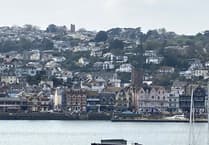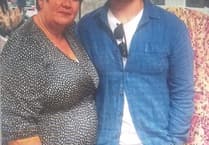A DARTMOUTH scuba diver has been on an historic mission to lay an underwater wreath in memory of almost 1,500 men who died in a First World War U-boat attack, 101 years ago.
Mike Rowley, of Lower Fairview Road, was among 12 British Sub-Aqua Club divers on the Livebait Squadron Expedition to survey the wrecks of three cruisers that sunk within an hour of each other at the hands of German U9 submarine.
During the expedition a commemorative wreath was laid on the HMS Cressy, the last ship to be sunk after the two other cruisers, the HMS Hogue and HMS Aboukir, were also hit off the coast of Holland in the early hours of September 22, 1914.
Mike, a member of Motor Vessel Maureen 2009, Special Branch, British Sub Aqua Club in Devon said he was honoured to be asked to join the expedition by Ipswich Dive Club (iDive) diving officer and BSAC council member Dave Lock.
‘I was invited by Dave to take part in the Livebait Squadron dives, as I worked with him on HMS Pathfinder last year,’ related Mike. ‘This time we conducted six dives, two each on the wrecks of HMS Cressy, Hogue and Aboukir. The wrecks are in good condition, but are all upside down, and some have been more salvaged than others. However, they’re all instantly recognisable as warships.’
The honour of laying the wreath went to Carol Wood, 56, of Southwold, a BSAC sports diver and member of iDive. Her god-daughter’s great-great-grandfather, William Henry King, perished in the attack.
Mike said: ‘This was a poignant series of dives on what are war graves. Because Carol had a connection to one of the men who died, she laid a wreath, which was a memorable moment.
‘As BSAC divers we always respect wrecks, particularly those that are war graves, and we’d never remove anything.’
Mike, who took up scuba diving in 1976, has undertaken thousands of previous dives in the UK and abroad and is the BSAC’s technical lead on the national diving committee.
He said: ‘The purpose of these dives was to record the wrecks and remove any fishing nets and other debris that may be tangled up in them and mark the loss of life as part of the Lost Beneath the Waves project.’
The expedition was led by Dutch diver Bart Goedmakers.
An appeal has been launched for information to help find out more about the crews on all three ships sunk in the attack, in which the number of lives lost was larger than for the sinking of the passenger ship RMS Titanic.
The ageing vessels were part of a patrol controversially nick-named the ‘Live Bait Squadron’ that patrolled the North Sea but was considered vulnerable to assault. On the day of the attack they were spotted by U9 captain Otto Weddigen. He noticed that the ships were steaming slowly without zigzagging around 22 miles off the Dutch coast.
Warships were supposed to zigzag to prevent them becoming an easy target, but submarines were not known to be in the area. The U-boat manoeuvred into position and fired a single torpedo that struck Aboukir on the port side, causing the cruiser to list and rapidly fill with water.
The captain of the Aboukir quickly gave the order to abandon ship and, believing he had hit a mine, ordered the Cressy and Hogue to close in and assist by picking up crew who had jumped into the sea.
The German U-boat then fired torpedoes at Hogue as her crew was lowering lifeboats to the crew of the Aboukir.
The damage from the two torpedoes, fired from a range of just 300 yards, quickly caused the Hogue to fill with water and sink within just 10 minutes.
The U-boat crew then turned their attention to the Cressy, which had begun to flee, and fired two torpedoes: the first missed, but the second struck the ship’s starboard side, causing damage that, in itself, would not have proved fatal.
However, U9 turned around and fired her last two torpedoes, causing catastrophic damage and sinking the Cressy in less than 15 minutes. As many as 837 survivors were rescued by British trawlers and Dutch merchant ships, but 1,459 men, mainly reservists and cadets, died.
Carol, who began diving in 1993, wanted to lay a wreath on the shipwreck after discovering, by pure chance, that her god-daughter’s great-great-grandfather, William Henry King, who had been rescued from the Aboukir, perished when the Hogue was sunk.
She said: ‘It’s a fascinating story. There seemed to be no real purpose for the patrols and a court of inquiry later accepted that the Admiralty had persisted with a patrol that was dangerous and of limited value, against the advice of senior seagoing officers.
‘William Henry King, who was from Gorleston near Great Yarmouth, had apparently been rescued from the water when the Aboukir was hit and, we think, was on board the Hogue when that too was sunk. It was then that he lost his life.’
Carol said visiting the wrecks was an eerie experience, but she is glad she became the first person to lay a wreath on the wreck of the Cressy, which lies upside down in 35 metres of water.
‘The dive was challenging as the sea conditions weren’t always calm,’ she said. ‘However, the visibility was quite good and there was reasonable light penetration.
‘We have to remember, it’s a war grave, so we were very careful not to disturb or remove anything from the wrecks. There’s a lot of cordite around them and some of the other divers saw shoes and boots, which take a long time to rot away.
‘The tragic loss of life was incredible. Far more people died on that day than when the Titanic sank. And these were mainly reservists and cadets.’
Carol appealed for anyone who may have information about crew members on the cruisers to get in touch.
Research by the Dutch-based Livebait Squadron Society has already been used to help make a documentary about the sinking of the three cruisers and more stories are being gathered for the LSS website.
Mike, who is also an honorary member of BSAC’s Burntwood Sub Aqua Club, near Litchfield, said: ‘The expedition was organised by the Dutch-based Livebait Squadron Society and I was delighted to have had the opportunity to join it.
‘We’re all now supporting the society in trying to gather information about who the men were and finding any photographs or recorded memories or what happened that day.
‘Carol and the expedition team are keen to hear from relatives of those who died and relatives of any survivors to piece together memories before they fade into history.’
The BSAC is the national governing body for scuba diving and is made up of 120 dive centres and 1,000-plus family-friendly and sociable clubs, run by volunteers, up and down the country and abroad.
It represents more than 30,000 scuba divers and snorkellers and welcomes new members, from complete beginners upwards, including those who have trained with other agencies.
iDive diving officer and BSAC Council member Dave Lock said: ‘This expedition showed BSAC at its best.
‘There were 12 divers from seven different clubs working together and supporting each other.’
BSAC chief executive Mary Tetley said: ‘BSAC is committed to protecting our marine heritage and environment.
‘The work done to survey these wrecks and protect what remains of them is commendable, and to have been able to conduct an act of remembrance by laying a wreath is something everyone connected with the expedition should be rightly proud of.’




